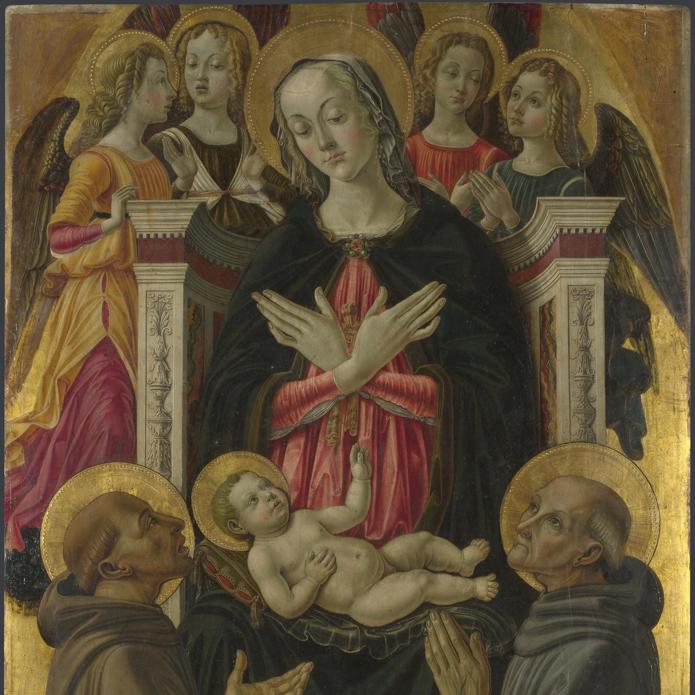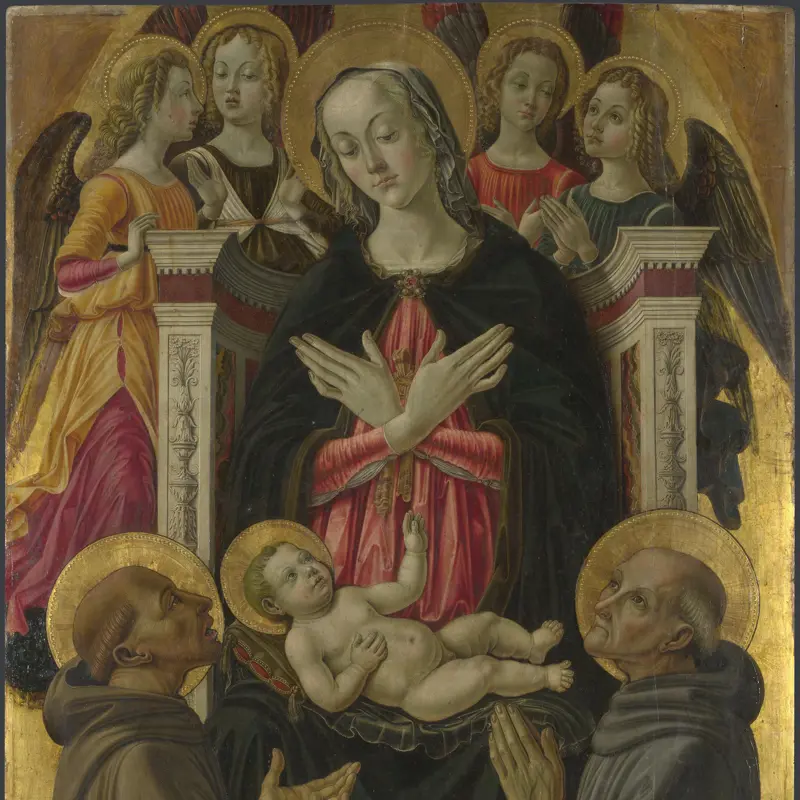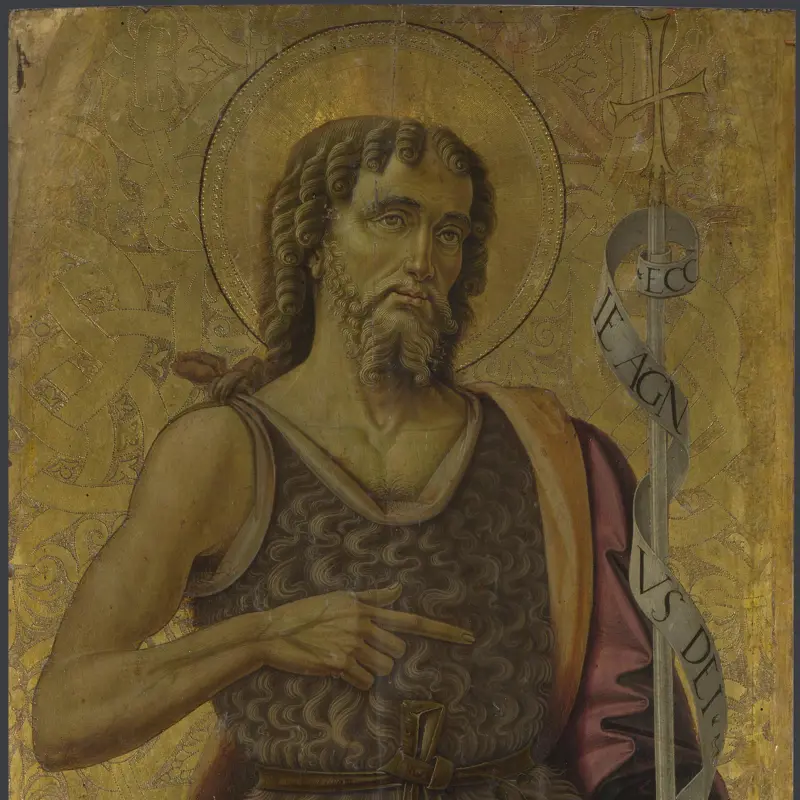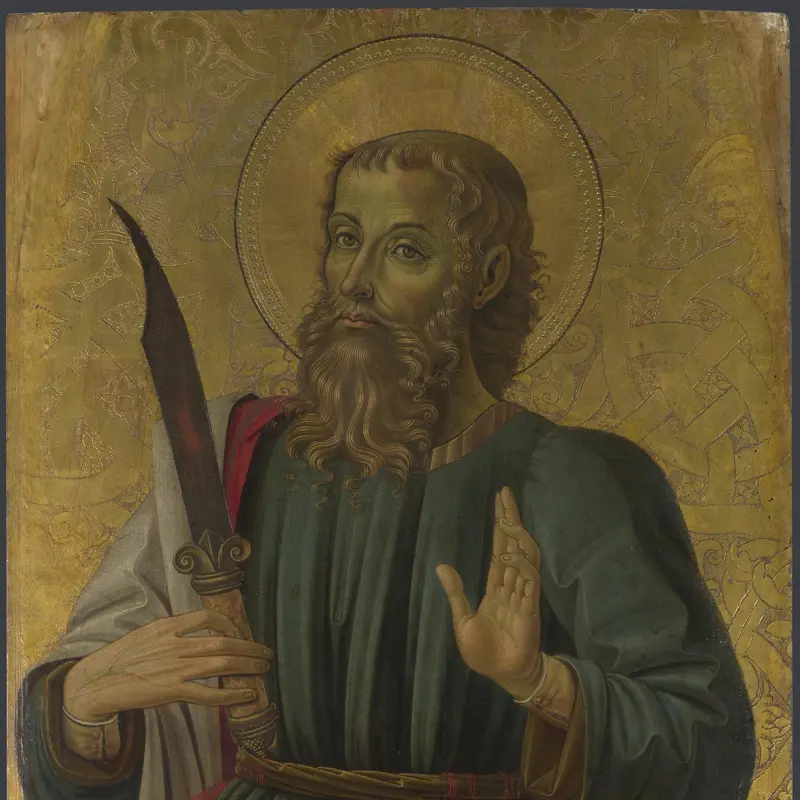Probably by Bartolomeo Caporali, 'The Virgin and Child with Saints, Angels and a Donor', probably 1475-80
About the work
Overview
Two saints kneel at the feet of the Virgin Mary, who sits on a marble throne and gazes down at the Christ Child. We're looking at Saint Francis, founder of the Franciscan Order, on the left and the famous Franciscan preacher Bernardino of Siena on the right. The small figure kneeling at the front is the altarpiece’s patron.
This arrangement of the Virgin and Child between Saints Francis and Bernardino was popular in Italy in the later fifteenth century. It first appeared in the work of the Florentine painter Benozzo Gozzoli, but Caporal reworked the composition, making it tighter and increasing its expressive power.
Gestures direct our eyes from bottom to top: we are drawn up from Saint Francis’s hand on the donor to his upturned palm, then to Christ’s, and then to the Virgin. Her still, crossed hands – which are emphasised by size and colour – stop the upwards movement.
Key facts
Details
- Full title
- The Virgin and Child with Saints, Angels and a Donor
- Artist
- Probably by Bartolomeo Caporali
- Artist dates
- Active 1467 - 1491
- Part of the series
- Altarpiece: The Virgin and Child with Saints
- Date made
- Probably 1475-80
- Medium and support
- Egg tempera and oil on wood
- Dimensions
- 122.6 × 83.2 cm
- Inscription summary
- Dated
- Acquisition credit
- Bought, 1881
- Inventory number
- NG1103.1
- Location
- Not on display
- Collection
- Main Collection
Provenance
Additional information
Text extracted from the ‘Provenance’ section of the catalogue entry in Martin Davies, ‘National Gallery Catalogues: The Earlier Italian Schools’, London 1986; for further information, see the full catalogue entry.
Bibliography
-
1872M. Guardabassi, Indice-guida dei monumenti pagani e cristiani riguardanti l'istoria e l'arte esistenti nella provincia dell'Umbria, Perugia 1872
-
1889National Gallery, Descriptive and Historical Catalogue of the Pictures in the National Gallery with Biographical Notices of the Painters: Foreign Schools, London 1889
-
1903J.C. Graham, The Problem of Fiorenzo di Lorenzo of Perugia, Perugia 1903
-
1904S. Weber, Fiorenzo di Lorenzo, Eine Kunsthistorische Studie, Strasbourg 1904
-
1912W. Bombe, Geschichte der Peruginer Malerei, Berlin 1912
-
1923U. Gnoli, Pittori e miniatori nell'Umbria, Spoleto 1923
-
1923R. van Marle, The Development of the Italian Schools of Painting, 19 vols, The Hague 1923
-
1951Davies, Martin, National Gallery Catalogues: The Earlier Italian Schools, London 1951
-
1961M. Davies, The Earlier Italian Schools, 2nd edn, London 1961
-
1985F. Santi, Galleria nazionale dell'Umbria. Dipinti, sculture e oggetti dei secoli XV-XVI, Rome 1985
-
1986Davies, Martin, National Gallery Catalogues: The Earlier Italian Schools, revised edn, London 1986
-
1987F. Zeri, La pittura in Italia: Il Quattrocento, Milan 1987
-
1989F. Todini, La pittura umbra: Al Duecento al primo Cinquecento, Milan 1989
-
1990M. Bury, 'Bartolomeo Caporali: A New Document and Its Implications', The Burlington Magazine, CXXXII/1048, 1990, pp. 469-75
-
2001
C. Baker and T. Henry, The National Gallery: Complete Illustrated Catalogue, London 2001
About this record
If you know more about this work or have spotted an error, please contact us. Please note that exhibition histories are listed from 2009 onwards. Bibliographies may not be complete; more comprehensive information is available in the National Gallery Library.
Images
About the series: Altarpiece: The Virgin and Child with Saints

Overview
Two of the most popular late medieval saints – Francis, who died in 1226, and Bernardino of Siena, who died in 1444 – present a young man to the Virgin and Child and a choir of angels; he’s the altarpiece’s patron. In the outer panels stand Saints John the Baptist and Bartholomew.
We don't know where this altarpiece came from, although Caporali seems to have worked mainly in Umbria. Neither do we know who the patron was, though clearly he was a man with a special devotion to the Franciscans, the religious order Francis founded.
This is one of the rare paintings of saints that actually resemble the person they depict. Bernardino was a famous travelling preacher who drew large crowds to his outdoor sermons. Many paintings of him were made immediately after his death – possibly from his death mask, which still survives – and show him as here: an old man with a toothless mouth and sunken cheeks.



